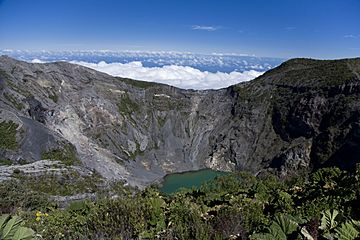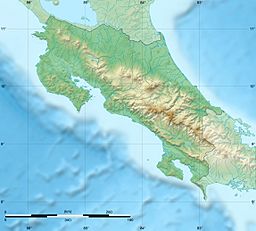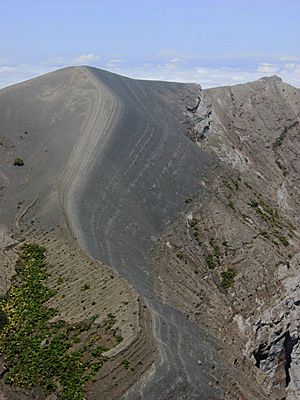Irazú Volcano facts for kids
Quick facts for kids Irazú Volcano |
|
|---|---|

Irazú Crater
|
|
| Highest point | |
| Elevation | 3,432 m (11,260 ft) |
| Geography | |
| Parent range | Cordillera Central |
| Geology | |
| Mountain type | Complex Stratovolcano |
| Last eruption | December 1994 |
The Irazú Volcano (which means Volcano Irazú in Spanish) is an active volcano in Costa Rica. You can find it in the Central Mountain Range, not far from the city of Cartago.
The name "Irazú" might come from old words meaning "point" and "thunder." Or, it could be a changed version of Iztarú, which was the name of a native village near the volcano. In Costa Rica, many people call it "El Coloso," meaning "The Colossus," because of the big events it has caused in the past.
The top of the volcano has several large holes called craters. One of these, named Diego de la Haya, holds a green lake that changes how deep it is. At 11,260 feet (3,432 meters) tall, Irazú Volcano is the highest active volcano in Costa Rica.
It's easy to visit Irazú from San José, the capital city. There's a road that goes right up to the craters, and a bus even goes there once a week. This makes it a very popular place for tourists to visit. The top of the volcano also has some television towers that send TV signals to San José.
On a super clear day, you might even be able to see both the Atlantic and Pacific Oceans from the top! But clear days are pretty rare up there, and the volcano's summit is usually covered in clouds.
The volcano is part of the Irazú Volcano National Park. This park covers a huge area of 5,705 acres (2,300 hectares). Inside the park, you can find different types of mountain forests. It's home to many animals like armadillos, owls, rabbits, foxes, woodpeckers, and hummingbirds.
About the Volcano
The Irazú volcano is a complex type of volcano, which means it's built up from many eruptions over time. It's the tallest active volcano in Costa Rica, covering about 500 square kilometers (193 square miles).
The volcano has a rough, cone-like shape. Temperatures at its top usually range from 3 to 17 degrees Celsius (37 to 63 degrees Fahrenheit). The coldest it's ever been was -3 degrees Celsius (26.6 degrees Fahrenheit), and the warmest was 23.2 degrees Celsius (73.4 degrees Fahrenheit).
Irazú is a stratovolcano, which means it's a tall, cone-shaped volcano built from layers of lava and ash. It has five main craters that are easy to spot. The two most important ones, because they've been active, are the Main Crater and the Diego de la Haya crater.
- The Main Crater is almost round with very steep sides. It's about 1,050 meters (3,440 feet) wide and 300 meters (980 feet) deep.
- The Diego de la Haya crater is about 600 meters (2,000 feet) wide and 100 meters (330 feet) deep.
Other craters include Playa Hermosa, La Laguna, and El Piroclastico.
Irazú is one of ten volcanoes that form a line through central and northern Costa Rica. Scientists have studied its age and found that it's at least 854,000 years old! It had big eruption periods around 570,000 years ago, and its most recent active time started about 136,000 years ago and continues today.
Recent activity has included lava flows and different types of explosions. Scientists used to think that magma (melted rock) would mix deep inside the volcano for thousands of years before an eruption. But studies of the 1963 eruption showed that magma might have traveled from deep within the Earth to the surface in just a few months! Some scientists even called this fast journey "the highway from hell."
Eruptions Over Time
Irazú has erupted many times throughout history. Records show at least 23 eruptions since the first one was written down in 1723.
Its most famous eruption started in mid-March 1963. This was just a few days before the US President John F. Kennedy visited Costa Rica. The eruption covered the capital city of San José and much of the central highlands with ash. This eruption kept going for two whole years!
Most of Irazú's historical eruptions have been explosive. There have also been many phreatic eruptions, which happen when hot magma heats groundwater, causing steam explosions. Some eruptions have even produced pyroclastic flows, which are fast-moving currents of hot gas and volcanic debris.
The most recent eruption of Irazú was short, lasting only one day on December 8, 1994. It was a phreatic eruption from a side vent and caused lahars, which are destructive mudflows made of volcanic ash and water.
Images for kids
-
White-nosed coati at Irazú
See also
 In Spanish: Volcán Irazú para niños
In Spanish: Volcán Irazú para niños
- List of volcanoes in Costa Rica
- Irazú Volcano National Park























